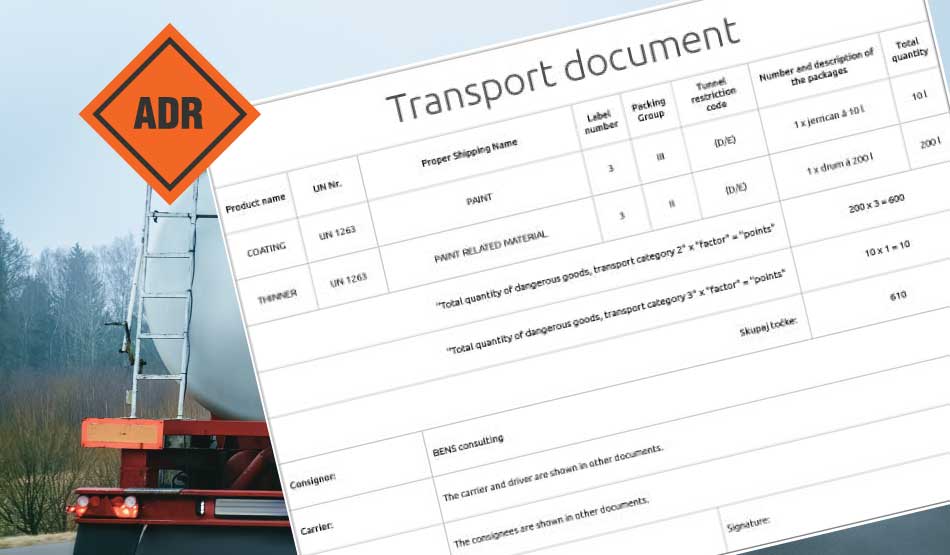21 Feb

Any transport subject to the provisions of ADR must be accompanied by a transport document. The form of the transport document is not prescribed. However, It’s content and the order of the data listed in the transport document are important.
The transport document must be drawn up by the sender and handed over to the carrier. The sender and the carrier must keep a copy of the transport document for at least 3 months.
The information must be provided in one of the official languages of the sending country, and if that language is not English, German or French, in one of these three languages.
Example: if we are sending dangerous goods from Slovenia to Croatia, the information on the transport document must be given in Slovenian AND in one of the official ADR languages (English, German or French).
It must be clear from the transport document at all times what is being transported in the vehicle (type and quantity of dangerous goods).
The basic information that must be contained in the standard transport document must be listed in the following order:
- UN number preceded by the letters “UN” (e.g. UN 1993)
- The official name of the goods, supplemented by the technical name in brackets, if so specified (e.g. FLAMMABLE LIQUID N.O.S. (ethanol))
- Number of sample hazard labels (class 1 specials: classification code, for lithium batteries label 9 and not 9A) (e.g. 3)
- Packaging group (e.g. III)
- Tunnel restriction code (e.g. (D/E)) – for transport involving passage through tunnels with restrictions.
Example: UN 1993, FLAMMABLE LIQUID, N.O.S. (ethanol), 3, III, (D/E)
In addition to the above data, the transport document must also include:
- Number and description of packages
- Total quantity of each type of dangerous goods with different UN number, official name of goods, packing group
- Sender’s name and address
- Name and address of recipient(s). If there are several recipients, their names and addresses may be listed in other documents accompanying the transport (e.g. on delivery notes or invoices).
- The statement “DANGEROUS TO THE ENVIRONMENT” if it is an environmentally hazardous product.
- The word “WASTE” in front of the official ADR name if it is waste.
If paragraph 1.1.3.6 applies (transportation of small quantities of dangerous goods – transport of up to 1000 points), the transport document for each transport group must state the total quantity and calculated value of dangerous goods according to the provisions of 1.1.3.6.3 and 1.1.3.6.4.
Example in the picture above.
Are you interested in how to simplify and automate the process of creating transport documents? Let me invite you to watch a video that presents the so-called Chemius ADR-API, which will significantly simplify your work.
If your company also needs help in managing the production of transport documents, we can help you. Write to me at simona.miklavcic@bens-consulting.eu and we will find a suitable solution.



Simona Miklavčič